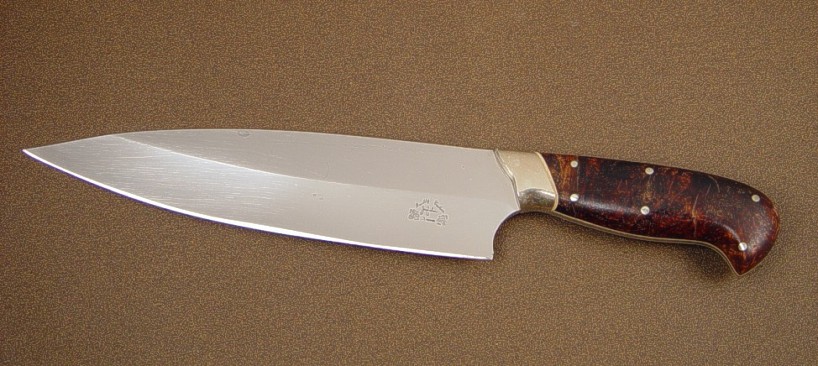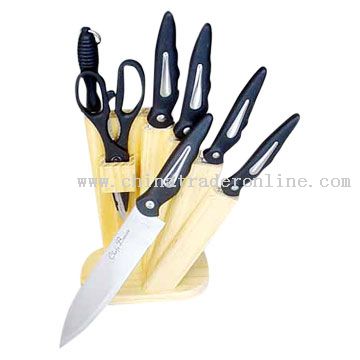
A Kitchen Knife
How to Properly Sharpen a Kitchen Knife
By John Sosa - Ezinearticles
Even the best kitchen knife will become dull over time. This can be caused by improper cleaning, cutting surfaces that are too hard, and everyday use. A variety of tools and techniques can be used to restore the blade.
By John Sosa - Ezinearticles
Even the best kitchen knife will become dull over time. This can be caused by improper cleaning, cutting surfaces that are too hard, and everyday use. A variety of tools and techniques can be used to restore the blade.
Honing
Dullness from regular use can be fixed with a honing steel. This tool is a rough steel rod with a handle. Knives have small microscopic teeth along the length of the blade that get bent and make them dull. Moving a honing steel along the edge will realign these teeth to restore sharpness.
To use a honing steel grasp the knife in your dominant hand and the steel in the other. Hold the steel with the tip pointing down perpendicular to a hard surface. Place the base of the blade against the steel at the highest point of the rod. Move the blade toward its tip and sliding it down the steal at a 20 degree angle and applying light pressure evenly. You should alternate sides after each stroke and repeat 6 to 8 times.

Sharpening
You will need to sharpen the blade if it is so dull it can not be honed. This involves using a tool that is hard enough to reshape the edge.
A diamond or ceramic steel can be used just like a honing steel. The difference is the hardness of the material the blade is moved against. These materials are abrasive enough to change the geometry of the blade.
A pull through sharpener is the easiest to use. This device has a slot with a V shaped cutting head made out of ceramic or carbide. You simply insert the knife at a 90-degree angle and pull down and back 3 to 4 times.
You will need to sharpen the blade if it is so dull it can not be honed. This involves using a tool that is hard enough to reshape the edge.
A diamond or ceramic steel can be used just like a honing steel. The difference is the hardness of the material the blade is moved against. These materials are abrasive enough to change the geometry of the blade.
A pull through sharpener is the easiest to use. This device has a slot with a V shaped cutting head made out of ceramic or carbide. You simply insert the knife at a 90-degree angle and pull down and back 3 to 4 times.

A whetstone is a professional way to sharpen a knife that also preserves more of the blade than other methods. It can be used with oil, water, or dry. The stone is more abrasive when used with a liquid. It will have a coarse grit on one side and fine grit on the other.
To use a whetstone with water it needs to be submerged for 5 to 10 minutes prior to use and reapplied during sharpening. To use the stone with oil apply enough to cover the surface of the stone. The stone should then be placed on a surface that keeps it from slipping such as a towel.

Start using the coarse grit side. Hold the knife by the handle with your dominant hand and stabilize it with the other hand. Put the blade point first against the stone at a 20 to 22-degree angle. Move the blade across the stone with moderate even pressure while maintaining the same angle. This should create a small burr. A burr is a thin projections along the edge you can feel. Perform this action 10 times for the first side and the flip and repeat for the other side. Turn your stone over to the fine grit side and duplicate the entire process. A honing steel should then be used in the manner described previously. The process is finished by washing the blade with hot water and dish soap and then drying it. This removes any metal particles and grit that may still be on the blade.



A Kitchen Knife

No comments:
Post a Comment
Hi, please feel free to share your comment here.
For example: Which pictures is the best?
Thanks,
Admin